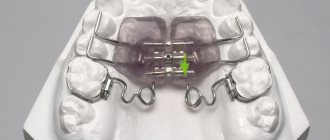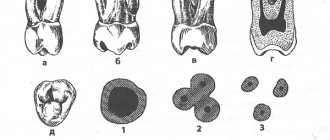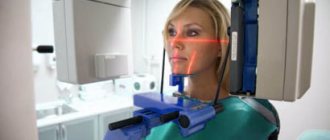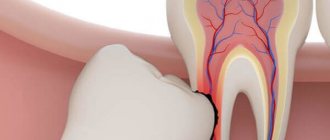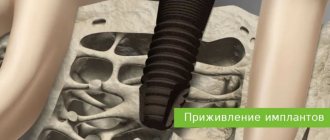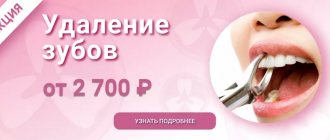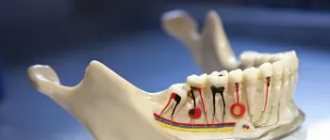The branch of dentistry such as orthodontics continues to develop. Today, there are many different orthodontic treatment methods that help not only improve the aesthetic appearance of the smile, but also normalize the function of the jaws.
Medicine does not stand still; orthodontics is developing more and more every year. Patients become more knowledgeable about smiles and attractiveness. More and more patients are complaining about a narrow smile; they want others to see as many teeth as possible when smiling. How and due to what, and most importantly at what age and what can an orthodontist do? Expansion of the upper jaw can be divided into conservative and surgical. It can also be divided into treatment in childhood, in mixed dentition and in adulthood when all teeth are permanent
Expansion of the upper jaw is indicated in the following cases:
- Micrognathia is underdevelopment of the upper jaw. It may be a consequence of rickets, endocrine diseases, injuries, too early loss of milk or permanent teeth, etc.
- Narrowing of the dentition of the upper jaw , resulting in a pathological crossbite.
- Difficulty in nasal breathing due to insufficient volume of the nasal cavities.
- Mesial occlusion.
- Protrusion of incisors.
Next, we will tell you what methods of expanding the upper jaw exist, what types of non-removable devices there are and what a non-removable plate for expanding the upper jaw is, as well as how the expansion is carried out surgically (surgery).
Correction of the position of the lower jaw using the Twin block device
Let's give the floor to orthodontist Irina Konstantinovna Shevchenko:
The patient's parents contacted the Nord Dental clinic with a complaint about improper eruption of the lateral incisors of the upper jaw (teeth 12 and 22).
During the consultation, the following problems were identified:
- incorrect position of the lower jaw
- deep incisal overlap
- decreased bite height in the lateral region
Distal bite , when the upper jaw protrudes noticeably forward, and the lower jaw lags behind in development, is the most common anomaly of the dental system.
The causes of distal bite can be either hereditary (genetic) or acquired (for example, artificial feeding).
The causes of dental anomalies are described in detail in the articles:
- A child’s beautiful smile is the care of loving parents
- Correction of distal and mesial bite using additional orthodontic equipment
After an X-ray examination (an orthopantomogram and a teleroentgenogram were taken) and an analysis of the bite on diagnostic models of the jaws, treatment with a Twin block apparatus was proposed .
orthodontic device Twin block
To carry out treatment with the Twin Block device, certain age indications are required: treatment can be carried out during the period of changing primary molars to permanent ones and changing canines.
In the period from 6 years to 12 years, such orthodontic appliances help create enough space for permanent teeth to properly erupt and fit into the jaw.
The Twin block device stimulates the growth of the lower jaw by artificially moving it forward
At the time of treatment, the patient was 9.5 years old.
The task of the Twin block apparatus is to rebuild the muscle memory of the masticatory muscles, stimulate the growth of the lower jaw during the period of general growth of the body and correct the position of the 12th and 22nd teeth.
After replacing baby teeth with permanent ones, a new, correct bite is fixed, and the treatment can be considered complete.
The Twin block device is manufactured individually for each patient, taking into account the planned treatment. Consists of two plates for the upper and lower jaw. Plastic pads are made on the chewing surface of the plates, which fix the position of the lower jaw in the desired position.
On the upper plate there is a screw for expanding the upper jaw, and metal elements (retraction arches) help fix the device and correct the position of the teeth.
As a rule , treatment with a Twin block lasts about 9 months , but depends on the speed of teeth change and compliance with wearing rules (at least 20 hours a day).
In this case, treatment took 1 year.
Treatment ends when the lateral group of teeth that secure the jaws in the new bite is replaced.
Irina Konstantinovna Shevchenko photographs the results of treatment
. As planned, the device stimulated the growth of the lower jaw, and by replacing the baby teeth of the lateral group with permanent ones, a new bite was fixed.
Conservative treatment methods, or a fixed device for expanding the upper jaw
In children, the most effective way to expand the upper jaw at the moment is a plate with a screw in the structure. The plates are removable and non-removable. All scientific studies show that an orthodontic structure works most effectively only if it is in the mouth for at least 24 hours a day, hence the conclusion that a non-removable technique works much more effectively than a plate that a child can remove at school, rest, lose, and so on. .
Honestly about the disadvantages of aligners
The main disadvantages of aligners are the price and the patient's responsibility for the result.
Price
The average cost of jaw expansion with aligners is higher than with braces. However, if we take into account the previously described risks of treatment with braces, it becomes clear that the overpayment covers possible additional costs for correcting complications.
In addition, many patients put off orthodontic treatment for years precisely because they are afraid of braces. Some are embarrassed to walk around with “hardware” in their mouth, others do not want to draw attention to problem teeth. Still others are stopped by their reluctance to change their lifestyle: follow a diet, devote a lot of time to hygiene, regularly visit the orthodontist.
Also, the design of braces used to expand the upper jaw in adults often affects diction, which may be unacceptable in certain positions and in some areas of activity.
But without timely treatment, improper occlusion leads to devastating consequences. Not only teeth suffer, but also the TMJ, digestive system, and musculoskeletal system; Facial asymmetry develops, posture worsens, and pain in the head and back appears.
From this perspective, it is clear that spending on orthodontic treatment is a necessary investment in a healthy future. In terms of effectiveness, aligners are in no way inferior to braces, but at the same time eliminate the inconvenience associated with wearing them.
Responsibility
The second disadvantage of correcting the bite on mouthguards is the patient’s responsibility for the result. If when using braces only the doctor is responsible for the outcome of treatment, then with aligners success depends on both parties. The fact is that the minimum time for wearing mouth guards is 22 hours a day, and the patient himself has to monitor compliance with this norm. In addition, aligners are removable and can be lost or absent-mindedly left in a restaurant, cafe, or near the sink where you brushed your teeth.
On the other hand, the patient actively influences the final result, participating in the course of treatment even at the planning stage. Using 3D modeling, you can see in advance the entire process of changing your bite and take into account almost any of your wishes. During treatment, day by day you will notice how your smile gets closer to ideal. And visual results of treatment are the best motivation to continue to follow the doctor’s recommendations.
HAAS device
The most common and convenient to use for both parents and doctors is the non-removable HAAS device. The device is fixed to the temporary teeth on the upper jaw by an orthodontist; it is absolutely invisible to others, but clearly and quickly performs its task. The most successful and appropriate time to work on it is when the central incisors are replaced with permanent ones, i.e. at the age of 7-8 years. The expansion of the upper jaw is carried out through the work of a screw, which the parents themselves tighten based on the recommendations of the attending physician.
Treatment of distal bite
With a distal bite , the upper jaw is pushed forward and the lower jaw is shifted back. The cause of the pathology is the underdevelopment of the lower and/or overdeveloped upper jaw.
External signs of distal bite:
lips do not close at rest; the lower lip falls under the upper teeth; the convex profile of the face; the chin looks small; the mental fold; the shortened lower third of the face is pronounced;
With this structure of the maxillofacial region difficulties arise with biting and chewing food, the chewing load on the teeth is incorrectly distributed, problems with diction, pain and disturbances in the functioning of the temporomandibular joint, breathing problems and various ENT diseases are possible.
For more information about the causes of distal bite, read the article Why, When and How to correct malocclusion
Depending on the inclination of the maxillary incisors, two subclasses of distal bite are distinguished:
The upper incisors are inclined towards the upper lip, class II, subclass 1 of the Angle classification
The upper incisors are inclined towards the palate II class, 2nd subclass of the Angle classification
The main goal of orthodontic treatment for distal occlusion is to restrain the growth of the upper jaw and stimulate the development of the lower jaw.
, additional orthodontic devices are used together with the brace system
- Herbst apparatus
- Facebow
- Palatal clasp and palatal expander
- Various rods fixed to micro-implants
Herbst apparatus
Herbst appliance - holds the lower jaw in a forward position, but does not interfere with opening the mouth and chewing food.
Despite its intimidating appearance, the Herbst apparatus:
- does not require long and painful habituation
- not noticeable to others because it is attached to the lateral teeth
- allows you to eat your usual food
- does not complicate oral hygiene
- gives good results in the correction of jaw anomalies
- can be installed together with a bracket system
Thanks to constant wearing , treatment using the Herbst apparatus gives results in 6-10 months. To consolidate the treatment results, it is necessary to wear a retention device for several years.
Facebow
A facebow is used in conjunction with braces if the following is required:
- movement or stabilization of the back molars while correcting the position of the front teeth
- normalization of the position of molars when removing the front teeth (in case of increased crowding)
The device consists of an intra- and extra-oral arch, which are made of medical stainless steel. Arches differ in the method of fastening :
- on the neck
- on the head
- on the neck and head
The method of attachment of the facebow depends on the orthodontic problem that the device helps solve.
Due to the bulkiness of the design, you need to use the facebow with increased attention:
- It is recommended to wear the device while you are awake
- You can only sleep with the device installed on your back
- Do not wear the device during sports activities
You need to wear a facebow 10-12 hours a day. The treatment period is several months.
Palatal clasps and expanders
These orthodontic appliances are used to stabilize the position of the first molars (in the case of extraction treatment) and expand the maxilla in patients with anterior crowding and a narrow jaw.
The devices have a similar design and in the video we will demonstrate the operation of the palatal expander.
Immediately after installation, the devices may cause inconvenience and impair diction, but after quick adaptation, this ceases to bother you.
Microimplants
It is not always possible to set the correct direction of tooth displacement using only the “shape memory” effect of the metal arch of braces.
You will learn about the principles of operation of braces in the article Why, When and How to Correct an Overbite
In such cases, it is necessary to install additional rods. Sometimes other teeth can be used as a support for attaching the rod.
But if the rod cannot be attached to the supporting tooth due to the danger of its mixing or it is necessary to apply efforts in a direction where there is no natural support, orthodontists use micro-implants.
- Orthodontic microimplants are small in size
- Installed under local anesthesia
- Painless and non-traumatic installation procedure takes no more than 5 minutes
- Microimplants do not fuse with bone tissue and are easily removed after treatment
Surgical expansion of the upper jaw
The surgical method for correcting the width of the upper dentition is that for an older patient and with the most pronounced defect of the upper jaw, the surgeon installs an apparatus in the area of the palatal suture, which carries out the “growth and expansion” of the jaw. Surgical expansion of the maxilla is the most effective method of expansion, although it is somewhat traumatic.
The device installed during the operation can be activated only on the third day. The first activation is carried out by the attending physician, and later this procedure can be carried out by the patient himself at home. The installed palatal expander must be worn for approximately 3-4 months after the maxillary expansion surgery has been performed.
In any case, the choice of method and determination of the period depends on the clinical picture, the desire of the patient and the capabilities of our dentofacial system.
Correction of any bite problems in children by our pediatric orthodontists:
- treatment with a smile, no stress for the child, no discomfort
- accurate diagnosis of more than 50 parameters before bite treatment
- treatment using both removable and non-removable equipment
- 100% solution to the problem of maxillary expansion
- noticeable treatment results after 2.5 months.
Ways to expand the jaw
There are several methods for expanding the jaw in adult patients: braces, aligners and, in extreme cases, surgery.
Bracket systems
The popular method of jaw expansion with braces has a significant drawback. When treated with braces, the effect is carried out due to the arch, under which the teeth tend to align. But the standard arch does not take into account the individual characteristics of the dental system, so uncontrolled expansion occurs. In some cases, improper orthodontic treatment on braces results in overexpansion, which can lead to recession of the gingival margin, the formation of an open bite and other complications.
Aligners
Jaw expansion with aligners is a completely controlled process. Prediction of changes is carried out at the diagnostic stage, before drawing up a treatment plan.
“A computed tomography scan is performed to determine bone reserve. For example, we expand the vestibular (buccal) side and see that the cortex is 3 mm. Accordingly, we will expand the dentition that much.”
Nana Gezalova, PhD, orthodontist, leading expert at the PROPRICUS clinic
Orthodontic aligners for jaw expansion are created in such a way that each subsequent one is slightly wider than the previous one. There is pressure on the teeth from the inside, and the jaw gradually, from one mouth guard to another, expands to the required parameters.
Need some advice?
Enter your phone number and we will give you a free consultation
I want a consultation
*By making an appointment you consent to the processing of your data
Compared to brace systems, aligners allow you to take into account all the features of the maxillofacial system and achieve the planned result.
The second advantage of aligners is maximum comfort for the patient:
- aligners are transparent trays that are invisible on the teeth;
- mouth guards are removable: they can be removed for an important event, speech or negotiation; they are also removed for eating and brushing teeth, so there is no need to review your diet and change habits, as when using braces;
- mouthguards are easy to use: they do not require complex care, they are easy to wash, put on and take off;
- quick adaptation period;
- autonomy of the patient from the doctor: switching from one set of mouth guards to another does not require a visit to the dentist, so you can go on a business trip or vacation.
Thus, when choosing a method of expanding the upper or lower jaw without surgery, in most cases, aligners are the best option. They are effective, comfortable and aesthetically pleasing.

